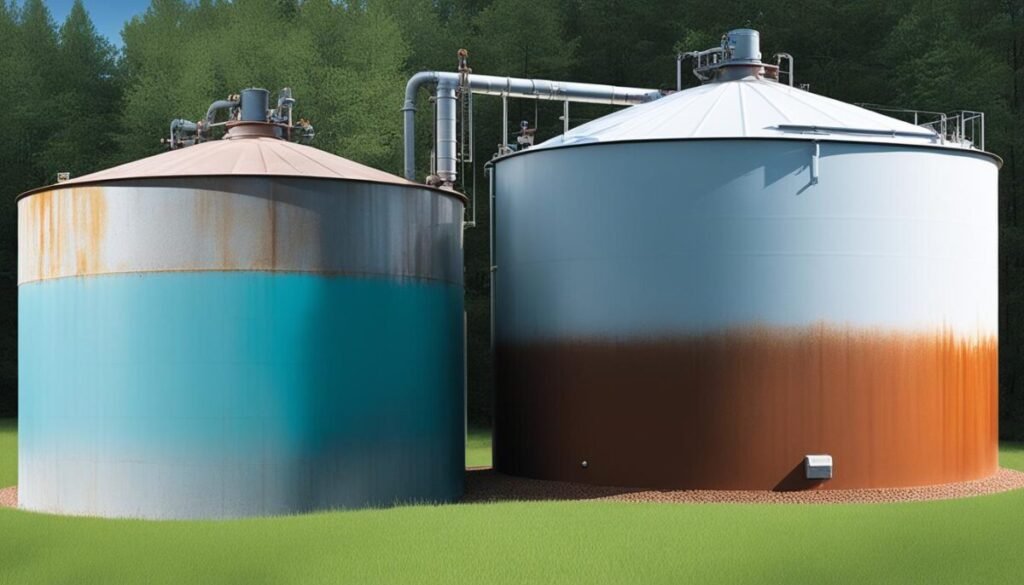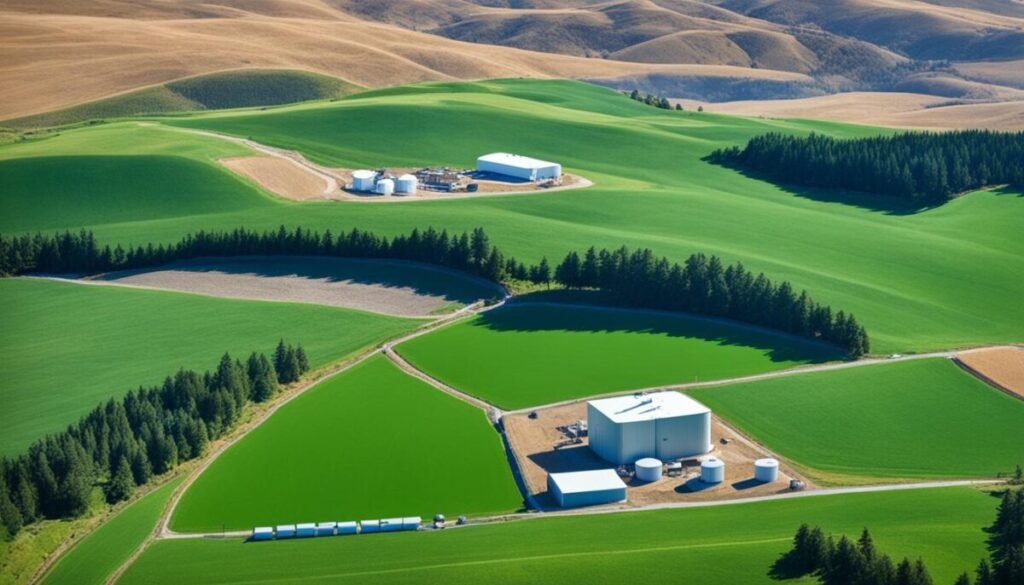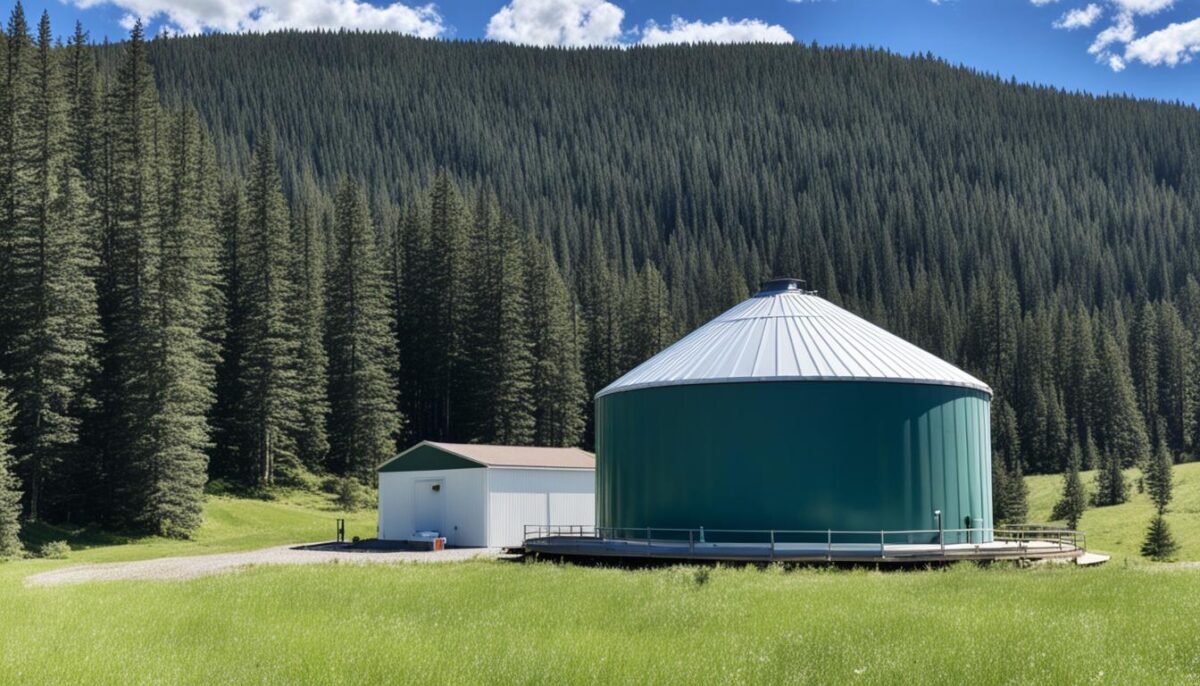Believe it or not, the average American family uses an astonishing 320 gallons of water per day. In the event of an emergency water shortage, would you be adequately prepared? If not, you may have thought about setting up large water storage tanks at your home or place of business.
In this article, you will learn how to set up a comprehensive emergency water storage system for your unique needs.
Key Takeaways
- Average American households use 320 gallons of water daily.
- Setting up large water storage tanks helps prepare for emergency shortages.
- Ensure the effective installation of your water storage tank to prevent issues such as flooding and property damage.
- Knowledge and careful planning are key to setting up a successful water storage system.
- The ultimate goal is to provide a secure, reliable water supply system that caters to your unique circumstances.
I always say: “Proper planning prevents poor performance”, a saying that holds especially true when preparing water storage tanks. Ignoring essential steps can result in far-from-ideal outcomes – flooding, property damage, and even personal injury. Understanding the system is key for complete food and water storage.
Table of Contents
Reddit Weighs In: Why Don’t More Preppers Do This??
This case study explores the intriguing topic of large water storage tanks for preppers, a subject that has garnered significant attention within the prepping community.
By examining insightful discussions from Reddit threads, we delve into the practicalities, challenges, and considerations surrounding the implementation of substantial water storage solutions.

Objective: Through this case study, readers can expect to gain valuable insights into the benefits and drawbacks of investing in large water storage tanks.
Additionally, they will learn about various factors to consider, such as water sourcing, maintenance, and potential issues like freezing and contamination.
Background Information
Context: The discussions featured in this case study originate from the r/preppers subreddit, a community dedicated to preparedness and self-sufficiency.
The initial prompt questioned why more preppers do not incorporate large water tanks into their preparations, sparking a lively discourse.
Community Profile: The r/preppers subreddit is a niche group of individuals actively engaged in planning for emergencies, natural disasters, and other disruptive events. Their interests align closely with the topic of water storage, as it is a crucial component of survival preparedness.
Analysis of Discussion
Key Points: Several key points emerged from the Reddit threads, including the advantages of large water tanks for ensuring an ample water supply during emergencies or droughts. However, concerns were raised about potential issues like freezing, contamination, and the logistics of refilling and maintaining such sizeable tanks.
Insights: A common insight was that the necessity of large water tanks varies significantly based on geographic location and climate. In areas with reliable water sources and minimal drought risk, smaller storage solutions may suffice. Conversely, in regions prone to water scarcity, substantial tanks become more practical and essential.
Personal Stories and Quotes
Contributor Highlights: One contributor shared their experience growing up with a cistern, emphasizing the importance of using opaque tanks to prevent algae growth and the necessity of regular treatment.
Another user mentioned having 25,000 gallons of water stored in their pool, showcasing the diverse approaches to water storage.
Differing Views: While some participants advocated for investing in large tanks, others argued that they were unnecessary in suburban areas with consistent water supply. These differing views highlighted the varying needs and priorities among preppers based on their specific circumstances.
Practical Applications

Based on the discussions, several practical recommendations emerged, including considering rainwater catchment systems, underground cisterns, and concrete tanks to mitigate freezing and contamination risks.

Additionally, establishing water delivery arrangements or accessing well water were suggested as potential solutions for refilling large tanks.

For those considering implementing large water storage tanks, key tips include assessing local climate conditions, drought risks, and water availability.

Additionally, factoring in the logistics of refilling, maintenance, and potential treatment requirements is crucial for successful implementation.
Conclusion
Summary: The discussions on Reddit threads highlight the complexities surrounding the decision to invest in large water storage tanks for prepping purposes.
While offering a reliable water supply during emergencies, these tanks require careful consideration of factors like location, climate, water sourcing, and maintenance.
Reflection: I firmly believe that having a substantial water storage solution is an essential component of any comprehensive preparedness plan. Water is a fundamental need for survival, and securing access to a reliable, long-term supply is crucial, especially in the event of disruptions to municipal water systems or during prolonged droughts.
While the specific storage capacity required may vary based on individual circumstances, I generally recommend investing in tanks with a minimum capacity of 5,000 gallons for most preppers.
This volume should provide ample water for drinking, cooking, hygiene, and basic sanitation needs for an extended period.
However, it’s important to note that large water tanks are not a one-size-fits-all solution.
Factors such as climate, geography, and available space must be carefully evaluated. In regions with severe winter conditions, underground cisterns or insulated tanks may be necessary to prevent freezing.
Conversely, in arid or drought-prone areas, even larger storage capacities or rainwater harvesting systems should be considered.
Proper maintenance and water treatment are also crucial aspects that cannot be overlooked.
Regular inspections, filtration, and potential treatment methods should be implemented to ensure the stored water remains potable and free from contaminants over time.
Ultimately, while the upfront cost and effort required to set up a large water storage system may seem daunting, the peace of mind and self-sufficiency it provides during emergencies or times of scarcity are invaluable for the dedicated prepper.
Call to Action: Readers are encouraged to explore the original Reddit threads (r/preppers, r/skoolies, r/TinyHouses) for further insights and to share their own experiences or perspectives on this topic.
Additionally, readers can visit our Privacy and Policy Page to understand how we handle user data and content on our blog.
References
- r/preppers: “Water tanks, why do so few people have water tanks?”
- r/skoolies: “Where to buy water tanks?”
- r/TinyHouses: “How practical is it to buy a big water storage tank (1500 gallons) instead of digging a well on an off-grid tiny house property?”
Choose the Proper Tank Material and Specifications
In aligning your prepper water storage strategies, it’s crucial to understand that the choice of your water tank material and its specifications can significantly impact its durability, maintenance, and overall functionality. From water retention to resistance against environmental factors, every detail matters.
The primary comparison often veers towards steel water storage tanks and polyethylene water tanks. The choice here relies heavily upon personal requirements and environmental conditions.

Compare Steel vs. Polyethylene Tanks
Typically, steel tanks, known for their durability and longevity, suit industrial applications or places with extreme weather conditions. On the contrary, polyethylene tanks, which resist rust and weather effects, are a smart choice for a wide range of applications, especially when resistance to weathering and rust is crucial. Polyethylene tanks are also lighter in weight, making them easier to handle during installation.
Color Choices and Algae Growth Prevention
Another essential tip within water storage tips is color selection. Dark shades like black and dark green can protect against sunlight and prevent algae growth. It’s a vital feature to consider, especially for tanks installed in regions with high sun exposure.
Consider Rainwater Catchment Systems
For eco-conscious individuals eyeing rainwater catchment systems, a well-selected water tank can decrease costs and serve dual functions, such as rainwater collection and shelter protection.
Consider Underground Cisterns
Underground cisterns are a great consideration for those who prioritise discretion and protection against environmental contaminants. In addition to preserving aesthetics, these tanks provide a cool, dark environment that discourages algae growth and maintains water temperature.
Assess Food-Grade Materials for Drinking Water
For those installing tanks for drinking purposes, considering food-grade certified tanks is a must. Safety is paramount, and ensuring your water tank material doesn’t adversely affect water quality is essential.
Every one of these indicators contributes significantly to your overall water tank specifications decisions. Remember, a well-planned water storage system is not only an investment but a guarantee of a reliable, clean supply of water when you need it the most.
The Art of Tank Placement: Maximize Efficiency and Safety
When prepping water supply and strategizing water storage for emergencies, the location of your storage tank plays a crucial role in maximizing efficiency and safety. From ensuring ease of access to reducing risks, effective tank placement is a critical aspect often overlooked.

To start with, consider the proximity of the site. Close proximity between your water source and the tank canteens in shortening plumbing runs and drastically reduces the resources used in this process.
Keep in mind that the ideal tank location would be with easy access for installation and maintenance, but far enough from your living or working area to prevent possible water damage.
Another crucial aspect to look into is the direction of sunlight exposure to your tank. Tanks exposed to direct sunlight can lead to an increase in water temperature and exacerbate algae growth. Therefore, it’s generally advisable to minimize direct sun exposure, especially for above-ground tanks. For instances, in the northern hemisphere, tanks should typically be placed on the north side of structures to reduce sun exposure, and the placement is reversed in the southern hemisphere.
- Consider positioning the tank on elevations like hills or high stands. This allows for gravity-fed water pressure, which can be a major savings in pump energy costs over the long term.
- Think about stormwater management and erosion prevention. This is paramount, especially when placing tanks near foundations or structures.
Lastly, always weigh the advantages and disadvantages of above-ground and underground tank installations. Both have pros and cons, which must be given serious consideration. Above-ground installations could be exposed to elements and potential contamination, while underground tanks demand additional steps and precision in the installation.
Remember, the goal is to ensure efficient, safe, and long-lasting water storage solutions for unpredictable situations. Judiciously choosing your tank’s placement is an art that can greatly aid in enhancing your preparedness for any situation.
Prepare the Site for Your Water Storage Tank
When it comes to the installation of a tank for emergency water storage, site preparation for water tanks is absolutely critical. It is the underpinning phase of the whole process where calculated precision makes the entire difference. A well-prepared site assures a rock-solid foundation, capable of supporting the tremendous weight of the tank when filled with water. Understanding how to properly prepare the site for your water storage tank while ensuring a safe water storage installation is therefore essential.
The choice of base materials for your tank foundation should be dictated by the size of the tank and the expected weight upon it when full. The materials can range from compacted earth to reinforced concrete. Considering that water weighs approximately 8.34 lbs per gallon, you can imagine the staggering amount of pressure that a large tank would exert on its foundation. That’s why it’s crucial to have a well-prepared and sturdy foundation.
For tanks to endure this pressure without causing any unforeseen complications, implement retainment walls in the base construction. These contribute greatly to structural durability, holding up against persistent weathering and the constant stress exerted by the tank’s weight.
But, what about timing?
Well, it varies depending on the materials used for the foundation. With non-setting materials like sand or gravel, the placement of the tank can be done immediately after the final inspection of the foundation. However, if you are using setting materials like concrete, a waiting period of at least 48 hours after pouring is necessary before you place the water tank on it.
As part of site preparation for your water tanks, you must evaluate the adequacy of the foundation material for the tank’s weight. One way to do this is by using calculations for pounds per square foot, and here’s an example table showcasing some typical required foundation sizes for various water tank sizes.
| Water Tank Capacity (Gallons) | Average Weight When Full (lbs) | Foundation Size (Sq. ft) |
|---|---|---|
| 500 | 4,170 | 8.34 |
| 1,000 | 8,340 | 16.68 |
| 5,000 | 41,700 | 83.4 |
| 10,000 | 83,400 | 166.8 |
This table takes into account the weight of the tank and water it can carry to guide you on the necessary foundation size. However, always consult with an expert or the tank manufacturer for specific instructions and requirements.
Preparing the site for your water storage tank is indeed a process that requires careful planning and observation of safety guidelines. It’s not just about getting a piece of land and dropping a tank on it; it involves assessing the right spot, preparing the foundation, ensuring proper placement, and eventually, facilitating a seamless and safe water storage installation.
Set Up Large Water Storage Tanks
Understanding how to correctly set up a water storage tank can feel daunting, but with careful planning and some professional guidance, it’s entirely feasible. The three crucial stages include safely moving and placing the tank, installing the essential plumbing connections, and setting up a reliable overflow and drainage system. Stringent practices at every stage can mitigate potential difficulties and help you avoid common pitfalls, ensuring the safety and longevity of your water storage setup.
Move and Place the Tank Safely
Moving and placing your large water tank requires thorough preparation. Safety is paramount, and this step is likely to require suitable handling equipment. The positioning should be precise to protect the base from being undermined. Remember, the chosen location should facilitate ease of access for both filling and maintenance, helping to ensure the tank continues to operate effectively for many years to come.
Essential Plumbing Connections for Optimal Functionality
The functionality of your water tank relies heavily on the plumbing connections. To install water tank plumbing connections effectively, consider both the efficient routing of your pipes and the alignment of pipework with existing infrastructures, such as stormwater systems. Equally important is the use of quality materials and professional workmanship for the plumbing, factors that can directly impact the efficacy of your water storage setup.
Install Overflow and Drainage Systems
Another crucial part of setting up your water storage tank involves establishing an effective overflow and drainage system. An overflow system is critical as it safely directs excess water away, protecting the tank from damage or erosion. Meanwhile, a sound drainage system ensures the emptying of your tank is straightforward and safe. Keep in mind that error-free installation of water tank overflow systems can be just as critical to the long-term success of your water storage setup as the tank itself.
Whatever the size or goal of your water storage setup might be, clear communication with professionals, rigorous planning, and following established safety protocols are vital. This ensures that your water storage system is set up to fulfil its function reliably and efficiently, providing you with a practical, long-term solution for your water storage needs.
Your Water Storage Needs
As you delve into the realm of prepper water storage solutions, an array of decisions await. To ensure that you create a robust and efficient system, some fundamental aspects need careful consideration. Aspects like location, accessibility, tank choice, and capacity calculation are essential to establish your water storage infrastructure. This section aims to guide you through the process.
Consider Location and Accessibility for Installation
Installing your water storage tank at an appropriate location is crucial. As a rule, the selected site should give you smooth access to the system for filling up the tank and for regular maintenance purposes.
Identify the Right Type of Tank for Your Situation
Understanding your specific requirements will facilitate your decision in selecting water storage tanks. If your needs are oriented towards home use with a pressurized system, then that will dictate a certain type of tank. On the other hand, for something like rainwater collection or garden irrigation, an atmospheric tank would be more suitable.
Determine Tank Capacity Based on Usage
Your ultimate storage goal will come down to determining water storage capacity based on your intended usage. The general guideline as per FEMA suggests a minimum water storage of one gallon per person per day. However, you may want to store more to deal with situations like extended power outages or agricultural requirements.
Conclusion
In summarizing the information, the task of setting up large water storage tanks is a multi-layered process that requires thoughtfulness, precision, and regular upkeep. From selecting the best material and location to considering the capacity needs and safety checks, each aspect plays a significant part in guaranteeing effective water storage solutions.
Regular Maintenance and Safety Checks
Taking care of your water storage tank is just as important as setting it up. It involves regular water tank maintenance, including inspecting the tank for possible leaks, contamination, and performing structural integrity checks. This ensures that the tank continues to operate at its peak, provides a safe water source, and has an extended lifespan. Remember, ensuring water tank safety is not a one-time effort; it’s a continuous responsibility.
Cost-efficient Practices in Water Tank Setup
Prioritizing cost-efficient water storage practices doesn’t mean cutting corners. It means making the most of your investment. Selecting the right sized tank based on your actual needs and the appropriate material that suits your environment and use can help minimize costs without compromising the tank’s quality and safety. Careful planning and factoring in the potential long-term usage can result in considerable savings.
In conclusion, the journey from ideation to setting up large water storage tanks and beyond needs thorough planning and execution. While it may seem overwhelming at first, following these guidelines can help ensure you have a safe and reliable water supply for your daily requirements or unplanned emergencies.


